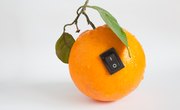
Batteries convert chemical energy into electrical energy, and it doesn't take a great deal of resources to create one -- you can make a working battery with a lemon. You may not get very much power from a lemon, but the principle of electricity generation is the same as that for the battery in an automobile. It's easy to learn about this principle when you can make simple batteries at home using two unlikely ingredients: coke and vinegar.
How a Battery Works
An electrochemical cell, which is the simplest type of battery, has three components: an anode, a cathode and an electrolyte. The anode and cathode are two different types of metal, one of which loses electrons more easily than the other. If the two metals touched each other, electrons would flow, but too slowly to create a significant current. When the cathode and anode are immersed in an electrolyte, which is usually an acid, chemical reactions create opposite charges on them, but the electrolyte prevents the charge from flowing. They can flow if you connect the cathode and anode with a wire, though. Moreover, ongoing reactions between the metals and electrolyte keep the battery "charged."
Making a Coke Battery
You can use any soft drink that contains phosphoric acid to make a voltaic cell, and Coke is a good example (diet or regular is fine, it's only the acid that matters). The aluminum from a Coke can also makes a good cathode, which is the negative terminal. Use snippers to cut a strip from the can and sandpaper to grind off the paint. You need a strip of copper for the anode, or positive terminal -- this you can usually find at the hardware store. Pour the Coke into a glass, immerse the strips and touch the strips with the probes of a voltmeter. You should get a reading of about 3/4 volt.
Making a Vinegar Battery
Vinegar also makes a good electrolyte, because it contains acetic acid. You can use copper for the anode, but zinc makes a better cathode than aluminum; if you don't have a zinc strip, use a galvanized nail, which is coated with zinc. You should get close to a volt from this cell. If you want to power an LED, you need to to wire two of these cells in series to double the voltage. To do this, connect the bulb to leads connected to the anode of one battery and cathode of the other, and use a third wire to connect the other pair of electrodes to each other.
Observing a Vinegar Cell
Because vinegar is clear, you can observe interesting effects on the electrodes in a vinegar cell. If you connect two of these cells in series and use them to power an LED, and you leave the LED on all night, you'll find a layer of black deposits on the zinc electrode in the morning. That's caused by copper atoms, which combine with hydrogen ions in the electrolyte and collect on the zinc surface. You should also see bubbles of hydrogen gas form on the copper strip as hydrogen ions from the acid combine with electrons to form hydrogen atoms, and the atoms pair up to form hydrogen molecules.
References
About the Author
Chris Deziel holds a Bachelor's degree in physics and a Master's degree in Humanities, He has taught science, math and English at the university level, both in his native Canada and in Japan. He began writing online in 2010, offering information in scientific, cultural and practical topics. His writing covers science, math and home improvement and design, as well as religion and the oriental healing arts.
Photo Credits
Alexander Shalamov/Hemera/Getty Images
